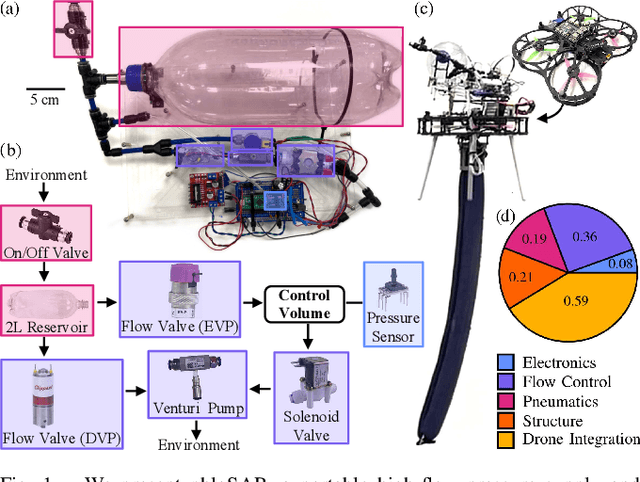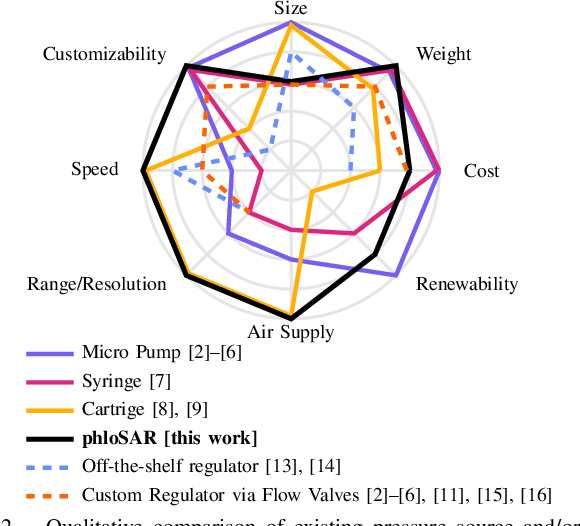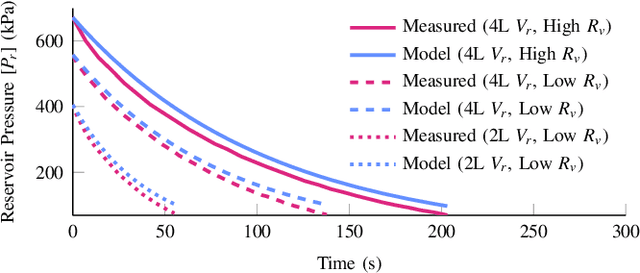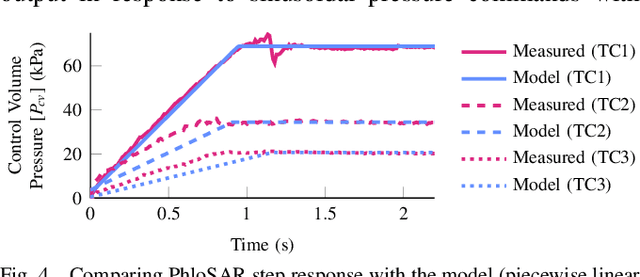Allison M. Okamura
Effect of Haptic Feedback on Avoidance Behavior and Visual Exploration in Dynamic VR Pedestrian Environment
Jun 26, 2025Abstract:Human crowd simulation in virtual reality (VR) is a powerful tool with potential applications including emergency evacuation training and assessment of building layout. While haptic feedback in VR enhances immersive experience, its effect on walking behavior in dense and dynamic pedestrian flows is unknown. Through a user study, we investigated how haptic feedback changes user walking motion in crowded pedestrian flows in VR. The results indicate that haptic feedback changed users' collision avoidance movements, as measured by increased walking trajectory length and change in pelvis angle. The displacements of users' lateral position and pelvis angle were also increased in the instantaneous response to a collision with a non-player character (NPC), even when the NPC was inside the field of view. Haptic feedback also enhanced users' awareness and visual exploration when an NPC approached from the side and back. Furthermore, variation in walking speed was increased by the haptic feedback. These results suggested that the haptic feedback enhanced users' sensitivity to a collision in VR environment.
Mechanically Programming the Cross-Sectional Shape of Soft Growing Robotic Structures for Patient Transfer
May 16, 2025Abstract:Pneumatic soft everting robotic structures have the potential to facilitate human transfer tasks due to their ability to grow underneath humans without sliding friction and their utility as a flexible sling when deflated. Tubular structures naturally yield circular cross-sections when inflated, whereas a robotic sling must be both thin enough to grow between them and their resting surface and wide enough to cradle the human. Recent works have achieved flattened cross-sections by including rigid components into the structure, but this reduces conformability to the human. We present a method of mechanically programming the cross-section of soft everting robotic structures using flexible strips that constrain radial expansion between points along the outer membrane. Our method enables simultaneously wide and thin profiles while maintaining the full multi-axis flexibility of traditional slings. We develop and validate a model relating the geometric design specifications to the fabrication parameters, and experimentally characterize their effects on growth rate. Finally, we prototype a soft growing robotic sling system and demonstrate its use for assisting a single caregiver in bed-to-chair patient transfer.
Loop closure grasping: Topological transformations enable strong, gentle, and versatile grasps
May 15, 2025Abstract:Grasping mechanisms must both create and subsequently hold grasps that permit safe and effective object manipulation. Existing mechanisms address the different functional requirements of grasp creation and grasp holding using a single morphology, but have yet to achieve the simultaneous strength, gentleness, and versatility needed for many applications. We present "loop closure grasping", a class of robotic grasping that addresses these different functional requirements through topological transformations between open-loop and closed-loop morphologies. We formalize these morphologies for grasping, formulate the loop closure grasping method, and present principles and a design architecture that we implement using soft growing inflated beams, winches, and clamps. The mechanisms' initial open-loop topology enables versatile grasp creation via unencumbered tip movement, and closing the loop enables strong and gentle holding with effectively infinite bending compliance. Loop closure grasping circumvents the tradeoffs of single-morphology designs, enabling grasps involving historically challenging objects, environments, and configurations.
Flying Vines: Design, Modeling, and Control of a Soft Aerial Robotic Arm
Mar 26, 2025Abstract:Aerial robotic arms aim to enable inspection and environment interaction in otherwise hard-to-reach areas from the air. However, many aerial manipulators feature bulky or heavy robot manipulators mounted to large, high-payload aerial vehicles. Instead, we propose an aerial robotic arm with low mass and a small stowed configuration called a "flying vine". The flying vine consists of a small, maneuverable quadrotor equipped with a soft, growing, inflated beam as the arm. This soft robot arm is underactuated, and positioning of the end effector is achieved by controlling the coupled quadrotor-vine dynamics. In this work, we present the flying vine design and a modeling and control framework for tracking desired end effector trajectories. The dynamic model leverages data-driven modeling methods and introduces bilinear interpolation to account for time-varying dynamic parameters. We use trajectory optimization to plan quadrotor controls that produce desired end effector motions. Experimental results on a physical prototype demonstrate that our framework enables the flying vine to perform high-speed end effector tracking, laying a foundation for performing dynamic maneuvers with soft aerial manipulators.
A Study of Perceived Safety for Soft Robotics in Caregiving Tasks
Mar 26, 2025Abstract:In this project, we focus on human-robot interaction in caregiving scenarios like bathing, where physical contact is inevitable and necessary for proper task execution because force must be applied to the skin. Using finite element analysis, we designed a 3D-printed gripper combining positive and negative pressure for secure yet compliant handling. Preliminary tests showed it exerted a lower, more uniform pressure profile than a standard rigid gripper. In a user study, participants' trust in robots significantly increased after they experienced a brief bathing demonstration performed by a robotic arm equipped with the soft gripper. These results suggest that soft robotics can enhance perceived safety and acceptance in intimate caregiving scenarios.
Force-Aware Autonomous Robotic Surgery
Jan 20, 2025Abstract:This work demonstrates the benefits of using tool-tissue interaction forces in the design of autonomous systems in robot-assisted surgery (RAS). Autonomous systems in surgery must manipulate tissues of different stiffness levels and hence should apply different levels of forces accordingly. We hypothesize that this ability is enabled by using force measurements as input to policies learned from human demonstrations. To test this hypothesis, we use Action-Chunking Transformers (ACT) to train two policies through imitation learning for automated tissue retraction with the da Vinci Research Kit (dVRK). To quantify the effects of using tool-tissue interaction force data, we trained a "no force policy" that uses the vision and robot kinematic data, and compared it to a "force policy" that uses force, vision and robot kinematic data. When tested on a previously seen tissue sample, the force policy is 3 times more successful in autonomously performing the task compared with the no force policy. In addition, the force policy is more gentle with the tissue compared with the no force policy, exerting on average 62% less force on the tissue. When tested on a previously unseen tissue sample, the force policy is 3.5 times more successful in autonomously performing the task, exerting an order of magnitude less forces on the tissue, compared with the no force policy. These results open the door to design force-aware autonomous systems that can meet the surgical guidelines for tissue handling, especially using the newly released RAS systems with force feedback capabilities such as the da Vinci 5.
phloSAR: a Portable, High-Flow Pressure Supply and Regulator Enabling Untethered Operation of Large Pneumatic Soft Robots
Mar 02, 2024



Abstract:Pneumatic actuation benefits soft robotics by facilitating compliance, enabling large volume change, and concentrating actuator weight away from the end-effector. However, portability is compromised when pneumatic actuators are tethered to cumbersome air and power supplies. While there are existing options for portable pneumatic systems, they are limited in dynamic capabilities, constraining their applicability to low pressure and/or small-volume soft robots. In this work, we propose a portable, high-flow pressure supply and regulator (phloSAR) for use in untethered, weight-constrained, dynamic soft robot applications. PhloSAR leverages high-flow proportional valves, an integrated pressure reservoir, and Venturi vacuum generation to achieve portability and dynamic performance. We present a set of models that describe the system dynamics, experimentally validate them on physical hardware, and discuss the influence of design parameters on system operation. Lastly, we integrate a proof-of-concept prototype with a soft robot arm mounted on an aerial vehicle to demonstrate the system's applicability to mobile robotics. Our system enables new opportunities in mobile soft robotics by making untethered pneumatic supply and regulation available to a wider range of soft robots.
Haptic Guidance and Haptic Error Amplification in a Virtual Surgical Robotic Training Environment
Sep 11, 2023Abstract:Teleoperated robotic systems have introduced more intuitive control for minimally invasive surgery, but the optimal method for training remains unknown. Recent motor learning studies have demonstrated that exaggeration of errors helps trainees learn to perform tasks with greater speed and accuracy. We hypothesized that training in a force field that pushes the operator away from a desired path would improve their performance on a virtual reality ring-on-wire task. Forty surgical novices trained under a no-force, guidance, or error-amplifying force field over five days. Completion time, translational and rotational path error, and combined error-time were evaluated under no force field on the final day. The groups significantly differed in combined error-time, with the guidance group performing the worst. Error-amplifying field participants showed the most improvement and did not plateau in their performance during training, suggesting that learning was still ongoing. Guidance field participants had the worst performance on the final day, confirming the guidance hypothesis. Participants with high initial path error benefited more from guidance. Participants with high initial combined error-time benefited more from guidance and error-amplifying force field training. Our results suggest that error-amplifying and error-reducing haptic training for robot-assisted telesurgery benefits trainees of different abilities differently.
Stiffness Change for Reconfiguration of Inflated Beam Robots
Jul 06, 2023Abstract:Active control of the shape of soft robots is challenging. Despite having an infinite number of passive degrees of freedom (DOFs), soft robots typically only have a few actively controllable DOFs, limited by the number of degrees of actuation (DOAs). The complexity of actuators restricts the number of DOAs that can be incorporated into soft robots. Active shape control is further complicated by the buckling of soft robots under compressive forces; this is particularly challenging for compliant continuum robots due to their long aspect ratios. In this work, we show how variable stiffness can enable shape control of soft robots by addressing these challenges. Dynamically changing the stiffness of sections along a compliant continuum robot can selectively "activate" discrete joints. By changing which joints are activated, the output of a single actuator can be reconfigured to actively control many different joints, thus decoupling the number of controllable DOFs from the number of DOAs. We demonstrate embedded positive pressure layer jamming as a simple method for stiffness change in inflated beam robots, its compatibility with growing robots, and its use as an "activating" technology. We experimentally characterize the stiffness change in a growing inflated beam robot and present finite element models which serve as guides for robot design and fabrication. We fabricate a multi-segment everting inflated beam robot and demonstrate how stiffness change is compatible with growth through tip eversion, enables an increase in workspace, and achieves new actuation patterns not possible without stiffening.
Finite Element Modeling of Pneumatic Bending Actuators for Inflated-Beam Robots
Jun 06, 2023Abstract:Inflated-beam soft robots, such as tip-everting vine robots, can control their curvature by contracting one side of the beam using pneumatic actuation. In this work, a general finite element modeling approach is developed and applied to characterize bending of inflated-beam soft robots. The model is tested on four types of pneumatic actuators used in these robots (series, compression, embedded, and fabric pneumatic artificial muscles) and can be extended to other designs. Actuators rely on two types of bending mechanisms: geometry-based contraction and material-based contraction. Geometry-based contraction implies shape-change of the muscles from a flat to an inflated shortened configuration that causes buckling of the inflated beam. Material-based contraction relies on material anisotropy to produce a contraction effect. The model depicts both mechanisms and accommodates for the complex and highly nonlinear effects of buckling and anisotropy. Simulation results are verified experimentally for each actuator type at three working pressures (10, 20, and 30 kPa). Geometry-based contraction achieves the largest deformation at accuracy values of 92.1% and higher once the buckling pattern is established, and 80.7% and higher for lower pressures due to the stress singularities occurring with buckling formation. Material-based contraction achieves smaller bending angles but is at least 96.7% accurate. The models are freely available online, and can thus be used by others to design inflated-beam robots, such as tip-everting vine robots. Labor and material waste can be reduced with this tool by optimizing designs that use knowledge of material properties and stress to distributions to enable bending and manage stress peaks.
 Add to Chrome
Add to Chrome Add to Firefox
Add to Firefox Add to Edge
Add to Edge